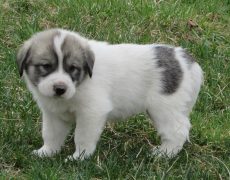Pyrenean Mastiff
Originally bred for guarding herds of sheep, the Pyrenean Mastiff is a breed of large dogs developed in the Pyrenees mountain of Aragon community in Spain. Emphatically muscular and strong, the Pyrenean Mastiff is characterized by a large, moderately long head, slightly triangular muzzle, small, almond-shaped eyes, medium-sized, hanging flat ears, broad, flexible neck, powerful, robust body, deep chest, moderately tucked up belly, straight, vertical legs, and moderately high set tail.
- Pyrenean Mastiff Dog
- Pyrenean Mastiff Pictures
- Pyrenean Mastiff Puppies
- Pyrenean Mastiff Puppy
- Pyrenean Mastiff
- The Pyrenean Mastiff
Quick Information
| Other Names | Mastin del Pirineo, Mastin d’Aragon, Mostin d’o Pireneu, Perro Mastin del Pireneo |
| Coat | Dense, thick, medium length, stiff, prickly |
| Color | White, clearly defined mask, spotted ears, distinctly outlined patches of golden yellow, medium gray, black, brown, sandy, light beige, marbled |
| Breed Type | Purebred |
| Category | Working, Guardian, Molosser, Mountain type |
| Lifespan | 12-14 years |
| Weight | 179-220 lbs |
| Size | Large |
| Height | 28-32 in |
| Shedding | Regular |
| Temperament | Calm, intelligent, affectionate, strong-willed |
| Hypoallergenic | No |
| Good with Children | Yes |
| Barking | Barks when necessary |
| Country Originated in | Spain |
| Competitive Registration/ Qualification Information | AKC/FSS, DRA, ACA, FCI, KC (UK), UKC |
Video: Pyrenean Mastiff Playing in Water
History
The true origin of Pyrenean Mastiff is a mystery, but it is thought to have evolved from the Molossers brought to Europe by the Phoenicians thousands of years ago. Since its development, the dog has been used as a protector of sheep from the attacks of thieves and predators like bears and wolves.
During the 1900s, after the Civil war in Spain, its population declined since it was quite expensive to keep a pet of its size. A group of dog enthusiasts started preserving the breed by protecting those that had the characteristics of ancient mastiffs since the 1970s. In 1977, the Pyrenean Mastiff was acknowledged as a modern purebred dog by the “Club del Mastín del Pirineo de España.”
It is now exported to other countries including the USA where it is encouraged as a pet by the Pyrenean Mastiff Club of America. The FCI acknowledged the breed in 1982.
Temperament and Behavior
Even though its imposing structure could be intimidating to some, the Pyrenean Mastiff is a gentle breed that is typically docile and even-tempered at home. Since it has the protective instinct of a guardian dog, it will not hesitate to fight and defend its family from a threat.
Although it gets along with children, their interaction should be carefully supervised because of the Pyrenean Mastiff’s large size. While it is cool and composed around humans, it is always suspicious toward strangers from whom it will never back away. It is generally good-natured to other dogs with whom it has been raised.
Care
Exercise
Since it is moderately energetic, the Pyrenean Mastiff does not need a great deal of activity. However, it may become restless and bored in a household with a sedentary lifestyle. It requires several walks a day and occasional outings.
Grooming
The Pyrenean Mastiff should frequently be brushed to remove matting and to manage shedding. Keep its ears as well as the areas around the eyes clean and dry by gently rubbing with a soft cotton cloth.
Health Problems
Although the Pyrenean Mastiff is not known to suffer from any specific health conditions, it may be affected by elbow dysplasia, hip dysplasia, and gastric dilation volvulus (bloating) owing to its large size.
Training
Since the Pyrenean Mastiff can be strong-willed and independent-minded at times, it needs a firm, persistent hand in training.
Socialization
Taking your Pyrenean Mastiff puppy on frequent outings will help it in habituating to new people, pets, and the surrounding environment. Give it the chance to sniff and explore at certain points on the outing. Make sure that you avoid socializing puppies in places that are often visited by sick dogs.
Obedience
Set up small training sessions, lasting 10-15 minutes twice or thrice a day. Start with basic commands and stick with one command in each session. Begin with the “sit,” then “lie down” and “stay,” and finally “come.”
Feeding
An adult Pyrenean Mastiff will need a diet formulated for large breeds. It, being a working dog, should be given high energy foods containing protein, carbs, and fat.
Interesting Facts
- The Pyrenean Mastiff is prone to drooling when eating, after drinking, or when it is hot.











